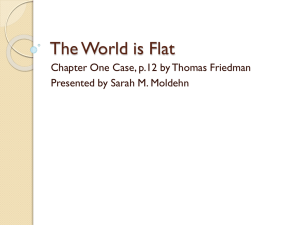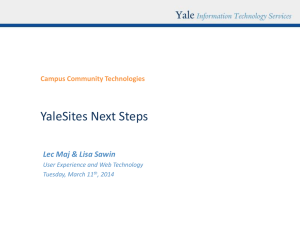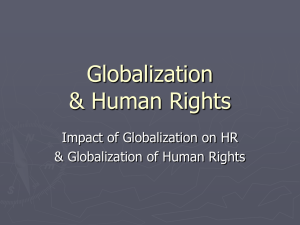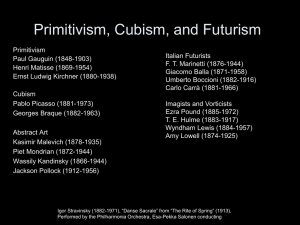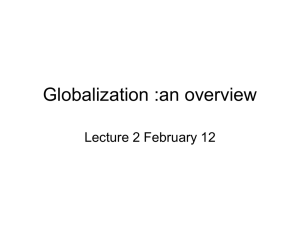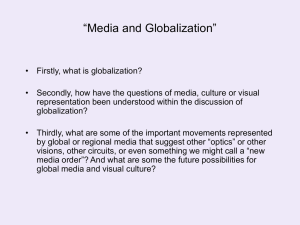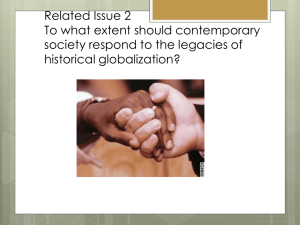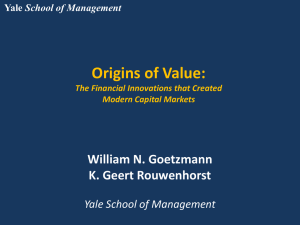Document
advertisement
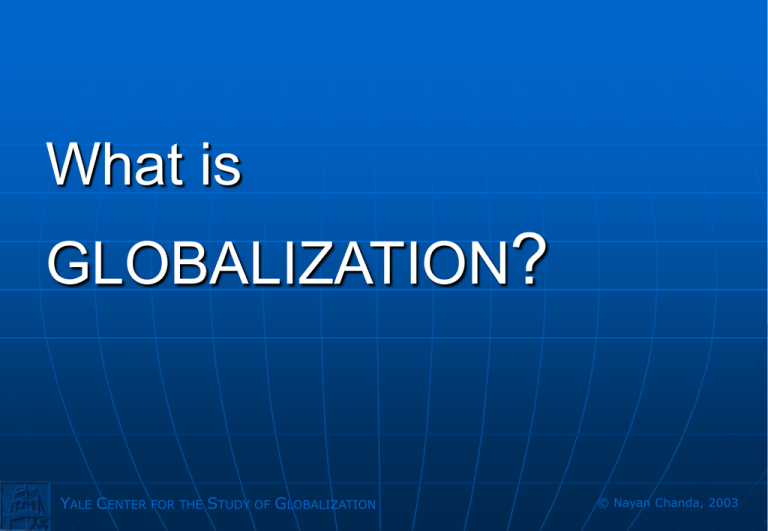
What is GLOBALIZATION? YALE CENTER FOR THE STUDY OF GLOBALIZATION © Nayan Chanda, 2003 For some It’s a Curse The McDonaldization of the world The conquest of American-style capitalism The dictatorship run by unelected bureaucrats in the World Trade Organization and the International Monetary Fund. YALE CENTER FOR THE STUDY OF GLOBALIZATION © Nayan Chanda, 2003 For others it’s modernized nirvana Free trade creates wealth The spread of ideas and information promotes democracy and awareness of human rights norms. The human experience is enriched by the sharing of cultures, foods and customs. YALE CENTER FOR THE STUDY OF GLOBALIZATION © Nayan Chanda, 2003 The word “globalize” appeared in the 1960s, meaning “to make global in scope or application” YALE CENTER FOR THE STUDY OF GLOBALIZATION © Nayan Chanda, 2003 In 1492 a German geographer named Martin Behaim created one of the first globes Martin Behaim YALE CENTER FOR THE STUDY OF GLOBALIZATION © Nayan Chanda, 2003 But globalization began long before Behaim Ancient human migrations took place 100,000 to 50,000 years ago YALE CENTER FOR THE STUDY OF GLOBALIZATION © Nayan Chanda, 2003 ...With our ancestors’ search for a better life First group of humans left central Africa 100,000 years ago, arriving in the Mediterranean 50,000 years ago, a second group arrived in Asia These were the first globalizers – migrants before there were any borders. YALE CENTER FOR THE STUDY OF GLOBALIZATION © Nayan Chanda, 2003 A leitmotif of history has been reconnecting the dispersed human community YALE CENTER FOR THE STUDY OF GLOBALIZATION © Nayan Chanda, 2003 This process of reconnection began thousands of years ago with simple acts like: Trading of goods Sharing of experiences YALE CENTER FOR THE STUDY OF GLOBALIZATION © Nayan Chanda, 2003 In the early stages of history the agents of globalization were: Traders Preachers Adventurers Soldiers YALE CENTER FOR THE STUDY OF GLOBALIZATION © Nayan Chanda, 2003 People like Alexander the Great felt the urge to conquer new lands... Alexander the Great 356-323 BC YALE CENTER FOR THE STUDY OF GLOBALIZATION © Nayan Chanda, 2003 while Genghis Khan sought to conquer other people YALE CENTER FOR THE STUDY OF GLOBALIZATION © Nayan Chanda, 2003 The desire to improve the taste of food or to find luxuries like silk or precious stones opened up trade routes between Europe, the Middle East, and Asia The Silk Road YALE CENTER FOR THE STUDY OF GLOBALIZATION © Nayan Chanda, 2003 Adventurers like Marco Polo were fascinated by the new lands and people they would encounter on their travels Marco Polo (1254-1324) YALE CENTER FOR THE STUDY OF GLOBALIZATION © Nayan Chanda, 2003 Fervor for the teachings of the Buddha drove devotees from India to the east and Chinese and other pilgrims to India Chinese pilgrim Fa Hien’s travels YALE CENTER FOR THE STUDY OF GLOBALIZATION © Nayan Chanda, 2003 Boats such as this carried traders and pilgrims Carving on the wall of Borobudur, 8-9th century YALE CENTER FOR THE STUDY OF GLOBALIZATION © Nayan Chanda, 2003 The monument at Borobudur may be the first temple of globalization, marking the intermixing of ideas and art from distant lands Borobudur, Indonesia YALE CENTER FOR THE STUDY OF GLOBALIZATION © Nayan Chanda, 2003 Christian missionaries traveled deep into Africa to spread the Message of Christ YALE CENTER FOR THE STUDY OF GLOBALIZATION © Nayan Chanda, 2003 The search for spices spurred shipping and literally brought a ‘taste’ of Asia into continental Europe. Black Pepper YALE CENTER FOR THE STUDY OF GLOBALIZATION © Nayan Chanda, 2003 This combination of trade, conquest, religion, and adventure led to a reconnecting of the Old World and the New Santa Maria, 1492 YALE CENTER FOR THE STUDY OF GLOBALIZATION © Nayan Chanda, 2003 Though originally headed for India, Columbus landed instead on San Salvador, an event that would change the world in ways no one could have predicted. YALE CENTER FOR THE STUDY OF GLOBALIZATION © Nayan Chanda, 2003 The New World inhabitants were decimated by germs brought from the Old World YALE CENTER FOR THE STUDY OF GLOBALIZATION © Nayan Chanda, 2003 The need for mine workers and plantation labor gave rise to the slave trade YALE CENTER FOR THE STUDY OF GLOBALIZATION © Nayan Chanda, 2003 Around the same time, Mexican silver found by the Spaniards boosted European trade with Asia YALE CENTER FOR THE STUDY OF GLOBALIZATION © Nayan Chanda, 2003 In the early 19th century the dwindling supply of silver led the British to replace it with Indian opium for trading with China. YALE CENTER FOR THE STUDY OF GLOBALIZATION © Nayan Chanda, 2003 And before too long the Chinese were hooked YALE CENTER FOR THE STUDY OF GLOBALIZATION © Nayan Chanda, 2003 Imperial Chinese opposition to the drug trade led to the Opium War the first war of globalization YALE CENTER FOR THE STUDY OF GLOBALIZATION © Nayan Chanda, 2003 Defeated China ceded Hong Kong to Britain YALE CENTER FOR THE STUDY OF GLOBALIZATION © Nayan Chanda, 2003 The world’s first multinationals helped to build colonial empires English East India Company’s first outpost in Surat, India, 1613. YALE CENTER FOR THE STUDY OF GLOBALIZATION © Nayan Chanda, 2003 Bringing oppression and suffering but integrating the world economy YALE CENTER FOR THE STUDY OF GLOBALIZATION © Nayan Chanda, 2003 A gift from a British governor in India helped to build Yale University Elihu Yale YALE CENTER FOR THE STUDY OF GLOBALIZATION © Nayan Chanda, 2003 Meanwhile, entire nations were being transformed by the interplay of trade, migration and colonial rule. An example is the former British colony Malaysia YALE CENTER FOR THE STUDY OF GLOBALIZATION © Nayan Chanda, 2003 Malaysia: A Country Shaped by Globalization Malaysia’s population todayfrom isfrom comprised Tin Miners China Rubber Rubber Tappers Plants from Brazil India of 30% ethnic Chinese and 10% ethnic Indians. YALE CENTER FOR THE STUDY OF GLOBALIZATION © Nayan Chanda, 2003 America’s Civil War drove the demand for canned food YALE CENTER FOR THE STUDY OF GLOBALIZATION © Nayan Chanda, 2003 Leading to the establishment of Malaysian tin mines, developed with labor from China Today ethnic Chinese make up thirty percent of the population YALE CENTER FOR THE STUDY OF GLOBALIZATION © Nayan Chanda, 2003 Malaysia’s new crop from the New World, rubber helped industry in faraway United States YALE CENTER FOR THE STUDY OF GLOBALIZATION © Nayan Chanda, 2003 Where a visionary industrialist named Henry Ford needed rubber to make tires for his new Model T automobile. Made of Rubber YALE CENTER FOR THE STUDY OF GLOBALIZATION Made of Rubber © Nayan Chanda, 2003 Import of Indian labor for the plantation changed Malaysia’s demography Ten percent of Malaysia’s population is ethnic Indian YALE CENTER FOR THE STUDY OF GLOBALIZATION © Nayan Chanda, 2003 Transfer of plants from the New World, like chili pepper, also changed Asia’s tastes YALE CENTER FOR THE STUDY OF GLOBALIZATION © Nayan Chanda, 2003 Admiral Columbus’s Hot Chili What if Columbus had introduced Chili by aggressively promoting an ad strategy financed by the King and Queen of Portugal, pushing this new product into homes across Asia? “STOP GLOBALIZATION! STOP CHILI!” YALE CENTER FOR THE STUDY OF GLOBALIZATION © Nayan Chanda, 2003 But, if globalization were stopped today, and all products introduced to Asia were to disappear, the resulting protest would be staggering… Bottles of ‘Chili’ would have appeared in many kitchens, but Asians would likely have objected to this assault on their culinary tradition of gentle food by this unfamiliar foreign product. YALE CENTER FOR THE STUDY OF GLOBALIZATION © Nayan Chanda, 2003
